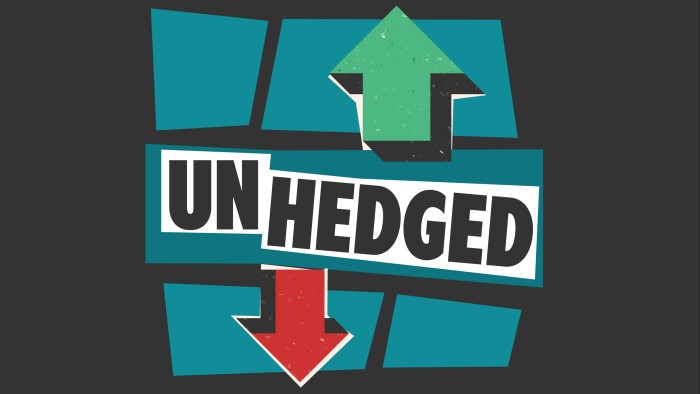This article is an on-site version of our Unhedged newsletter. Premium subscribers can sign up here to get the newsletter delivered every weekday. Standard subscribers can upgrade to Premium here, or explore all FT newsletters
Good morning. We could all really use a calm day in markets today. As of this writing, futures markets suggest that it’s not going to happen. But perhaps bargain hunters, dip-buyers, short-coverers, volatility hedgers, optimists and algorithms can turn things around. If not, email us a reassuring word: [email protected] and [email protected].
What just happened?
It is probably a mistake to expend too much analytical energy on what happened in the US market on Thursday and Friday. This was a panic, and in a panic there is more noise than meaning. And the panic may continue today. We already discussed the thing that struck us most about the post-liberation day freakout: the weak dollar. But we might usefully summarise what issues the market is wrestling with, however irrationally. To start, here is the 15 worst performers in the S&P 500 during the sell-off:
There are, to simplify quite a bit, two main kinds of companies here (some are a mix of both types). The first are companies whose supply chains are going to be absolutely whacked by the tariffs. The tech importers fit there (Micron, Western, Dell, GE HealthCare). The second is energy, commodity and financial companies that are very sensitive to rising odds of recession (APA, Diamondback, Freeport, Apollo). This nicely sums up the first two questions the stock market is wrestling with. On the one hand, there is the specific hit companies will take from tariffs; on the other, there is the effect that a shock to the economy might have on demand in general.
On the first point — the earnings hit — Scott Chronert of Citigroup estimates that an average tariff rate over 20+ per cent, sustained indefinitely, would reduce earnings per share on the S&P 500 by 11 per cent. By reducing growth rates and increasing risk, it should depress the valuation of those earnings, too. All in, he thinks incorporating persistent tariffs at the current level would, on its own, bring the fair value of the S&P index to 4700, 7 per cent below its current level. This can only be a rough and ready calculation; much depends on how other countries respond, tax cuts and whatever else. And, Chronert notes, “this work does not factor in potential impact of sentiment shocks.”
On the question of impact on aggregate demand, JPMorgan’s chief US economist Michael Feroli is now projecting that full year real GDP growth will fall slightly, unemployment will rise to 5.3 per cent at year’s end (it is now 4.2 per cent), and core PCE inflation will rise to 4.4 per cent. He writes:
The most readily quantifiable effect of higher tariffs on activity runs through higher inflation, and hence lower real income and lower real consumer spending. The pinch from higher prices that we expect in coming months may hit harder than in the post-pandemic inflation spike, as nominal income growth has been moderating recently, as opposed to accelerating in the earlier episode. Moreover, in an environment of heightened uncertainty consumers may be reluctant to dip too far into savings . . . we have no reason to revisit our prior conclusion that [policy] uncertainty will be a headwind to capex growth later this year
In sum: eek. But we can take some comfort from the fact that inflation is the key mechanism, because if the pandemic taught us anything, it’s that inflation is hard to forecast, both as it rises and as it falls. The economic logic for a slowdown is clear, but any forecast must be made humbly at this point. This is all new.
In addition to the hits to earnings and demand, a third factor has to be priced in: the sheer unpredictability of Trump’s trade policy. In particular, the method of arriving at the tariffs rates announced last week was so bizarre and so wildly at odds with the administration’s talk about “reciprocity,” that investors can only speculate about what might be coming next. Matt Klein sums up over at The Overshoot:
The . . . announcement and implementation of these tax increases has made the incompetence and thoughtlessness of this administration even more obvious. The nonsensical “reciprocal” tariff rates published on April 2 were, as best as anyone can tell, generated by a chatbot. Officials repeatedly lied about how the rates were calculated, claiming that each economy’s “tariff and non tariff barriers” policies were quantified individually . . . Traders have responded by placing a “moron risk premium” — to borrow a term from the U.K.’s mini-budget misadventure — on US assets
What is next? The Trump administration caused this scare, and the market is counting on it to project calm now. The best way for it to do that would be to tell markets that the tariffs are subject to negotiation. Treasury Secretary Scott Bessent, National Economic Council director Kevin Hassett, Commerce Secretary Howard Lutnick, and trade adviser Peter Navarro did the rounds of the news shows yesterday. Unhedged does not recommend watching them all consecutively, but there was a unified message to be heard. It might be summed up as follows: These tariffs are going to happen on April 9, without any last-minute reprieve. Countries are currently lining up to negotiate with us. But those negotiations will take a long time, because the crucial issue is not tariff rates but non-tariff “cheating” (currency manipulation, subsidies, VAT taxes, industrial standards, et al).
No tariff reductions soon, then. That is the message from the White House as of yesterday. But if the market continues to rebel this week, this could change.
Jobs: a warning from Canada
The US labour market added 228,000 jobs in March, well above February’s 151,000 new jobs and economists’ consensus estimate of 135,000. No one paid much attention, for obvious reasons, but you can be sure they would have had jobs undershot rather than overshot expectations. Bullet dodged, then.
There was surprising strength in retail and transportation, and, despite Doge’s efforts, the US government only shed 4,000 employees, less than February’s 11,000 bureaucrats lost. There was, it must be admitted, some less-than-ideal news in the report. The unemployment rate ticked up from 4.1 per cent to 4.2 per cent — its highest reading since November, though, as Jason Pride at Glenmede Investments noted, that may have been driven by an increase to the size of the labour force. At the same time, wage inflation had its lowest year-over-year increase since the immediate aftermath of the pandemic, and was flat-to-up month-over-month. For the Fed, this is mixed news: it suggests that wage-driven inflation pressures are easing, but also signals that employers could be holding down salaries on fears of a slowdown, and lay-offs might be next.

We could also point to more subtle issues. But for goodness sake, let’s take the win: the hard jobs data continues to be good, despite more and more bad sentiment data. Yes, the ISM services report, also out last week, showed an 8 point drop in its employment index. But it is a noisy series and, according to Numera Analytics, it tends to anticipate moves in the labour market by about a year. We could have a long runway before the hard data weakens.
More concerning: Canada’s jobs report, which also landed Friday. It missed estimates by a wide margin: a 33,000 job contraction, despite estimates that the economy would add 10,000 jobs. The report showed the first jobs contraction and the slowest pace of wage growth since early 2022.
Canada has been staring down potentially catastrophic tariffs from the US, its biggest trade partner by a wide margin, for nearly 2 months now. Businesses have had a much longer time to think about the threat and adjust payrolls accordingly. The US got its own tariff shock this week — how long until it shows up in the job numbers? Canada suggests it’s a matter of months.
(Reiter)
One good read
The egg trade.
FT Unhedged podcast

Can’t get enough of Unhedged? Listen to our new podcast, for a 15-minute dive into the latest markets news and financial headlines, twice a week. Catch up on past editions of the newsletter here.
Recommended newsletters for you
Due Diligence — Top stories from the world of corporate finance. Sign up here
Free Lunch — Your guide to the global economic policy debate. Sign up here
